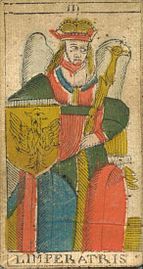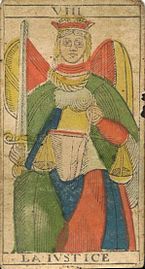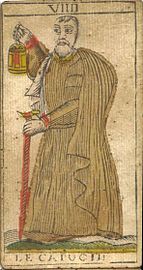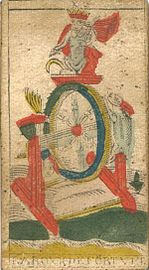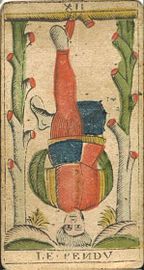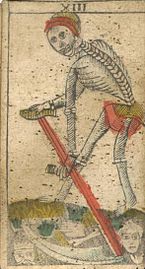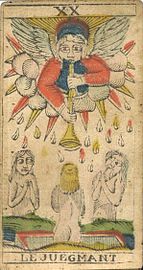|
Tarot de Besançon The Tarot de Besançon, also called the Besançon Tarot,[1] describes an historical type of Tarot pack used for playing card games that was made in south Germany, France and Switzerland, including the town of Besançon.[2] HistoryThe Tarot de Besançon was derived from the older form of the Marseille type, now known as ‘Type-I Tarot de Marseille’,[3] compared with which it portrays characteristic differences, notably that the Popess (trump II) and the Pope (trump V) are replaced by, respectively, Juno and Jupiter. The earliest cards of this pattern came from Strasbourg in the early 18th century.[4] During the mid-18th century other sources of manufacture included Colmar, Konstanz, Ulm and Munich, but the majority were manufactured in Alsace. The packs take their name from the eastern French town of Besançon, to which the cardmakers moved their production in the early 19th century. The so-called Tarot de Besançon was superseded in the late 18th century by French-suited tarot packs. The Swiss Tarot pattern, which emerged in Diessenhofen around 1860, was derived from the Tarot de Besançon.[2] DescriptionTypical of card packs of the Besançon type is that the cards traditionally depicting the Papess and the Pope were redesigned to portray the Roman gods, Juno and Jupiter. It is assumed that this renaming took place in order to avoid upsetting religious sensitivities in an area of distribution marked by confessional contrasts. Other features of the Besançon type compared with the Marseille Tarot are:
Known manufacturers of card packs of this type are:
The Besançon Tarot includes the Tarot 1JJ, which forms its own sub-type (see details in that article), and the Tarot d’Épinal, which also has specific variations in design. It was manufactured around 1830 or 1850 by the cardmaker, Pellerin, in Épinal, the wood engraving comes from François Georgin (1801–1863). Among the features are an additional card with the title, Consultant, which was clearly used as a Significator, which is why it may be assumed that the cards were also used for divinatory purposes and not, like other packs of this type at that time, used exclusively for playing cards. The pictures below, showing the 22 trump cards, come from a pack with coloured wood carvings produced by Renault from Besançon around 1820–1830. The pack is based on a c. 1800 design by Jean Jerger, also from Besançon.
References
Literature
|



